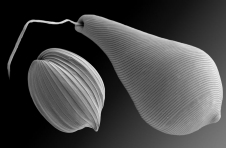


 |
 |
 |
|
Department
of Biological Sciences
|
||
|
|
Research
Areas
The
primary research focus in the Russell lab is to elucidate the structure,
function and evolution of selected eukaryotic protein-RNA complexes
(RNPs). Our strategy employs single-celled eukaryotic microbes (specifically
protists) as model systems in which
to study cellular processes that are shared with more complex organisms
such as humans. One of our long-term objectives is to understand some
of the mechanisms of human disease caused by alterations to the structure
and function of these macromolecular complexes. Our research is also
providing novel insights about the cellular biology of previously unexplored
eukaryotic taxa. Our main areas of interest include:
Small ribonucleic acids are an important class of cellular molecules
that regulate gene expression in all organisms. The recent discovery
and manipulation of small interfering RNAs (siRNAs)
and microRNAs (miRNAs) has revolutionized
our understanding of several areas of eukaryotic biology and consequently
led to the awarding of the 2006 Nobel Prize for Physiology or Medicine
to Andrew Fire and Craig Mello for their pioneering work in the RNAi field.
In our lab we are investigating two main classes of small ribonucleic
acids, the small nucleolar
(sno) RNAs and the small
nuclear RNAs (snRNAs). The primary
cellular function of snoRNAs is to target the modification of
other classes of stable RNAs such as ribosomal RNAs, snRNAs,
and transfer RNAs. They are a
very ancient class of molecules and homologs
of snoRNAs are also found in archaeal
organisms (Omer et al., Science, 2000). We still have much to learn
about the possible cellular targets and functions for snoRNAs
and the recent characterization of a snoRNA
that regulates the alternative splicing of a serotonin receptor messenger
RNA (Kishore and Stamm,
Science, 2006) indicates that
many surprises still await. Our lab is identifying and characterizing
snoRNAs in different protist species
with a particular interest in the organism Euglena gracilis. We are determining the
functional targets for these new snoRNAs and
we are also establishing in vitro
systems to study the structure and mechanism of action of these
RNAs and their associated proteins. SnRNAs
are small RNAs that are integral components of the spliceosome, the massive protein-RNA
complex that mediates the removal of introns
from eukaryotic messenger RNAs. Our lab is identifying snRNAs
and other spliceosomal components in diverse
eukaryotic organisms. We are particularly interested in the snRNAs
that are components of the minor
spliceosome, the complex that removes an atypical class
of spliceosomal introns.
By studying both snoRNAs and snRNAs
in phylogenetically diverse eukaryotes we
are also addressing questions about the evolutionary history of these
molecules. Protists
make up most of the phylogenetic diversity within eukaryotes and several key biological
discoveries were initially made in these organisms. One of the first
identified catalytic RNAs (a self-splicing group I intron)
(Thomas Cech, Nobel Prize in Chemistry, 1989)
and the telomerase RNA-mediated mechanism of eukaryotic chromosome end
maintenance were first characterized in the ciliated protozoon Tetrahymena. Introns are intervening sequences that are expressed
and subsequently removed from primary RNA transcripts. They most often
interrupt the coding regions of genes. Spliceosomal introns are a class of introns found exclusively in eukaryotic organisms and predominantly
reside within protein-coding genes. The origin(s) of spliceosomal
introns (and of the spliceosome
itself) is one of the most hotly debated questions in evolutionary biology.
Based on structural and mechanistic similarities, some researchers believe
that components of the spliceosome may have
evolved from a group II intron. Our lab is identifying and characterizing introns
in protists and other unicellular eukaryotes such as fungi. We are examining
the conservation of these introns between different eukaryotes, the
possible relationships amongst the different intron classes and what
these observations may reveal about the age and origin of eukaryotic
introns. We are also studying novel intron types, such as the usual
class of introns found in Euglenid messenger RNAs, and we are also examining
other protist species for the presence of new classes of introns. There
is a wealth of new genome sequence data available for many protists
including some Phytophthora species (Science, Sept. 2006). There are also genome sequencing projects currently
underway to characterize representatives of some of the more poorly
sampled eukaryotic taxa of evolutionary, economic or medical significance. |
|
Page last updated August 2007
|
 |
|
University
Hall, University of Lethbridge, Alberta. Photo courtesy of George Runschke,
August 2007
|